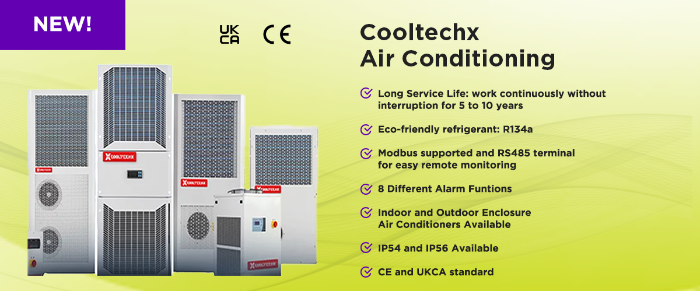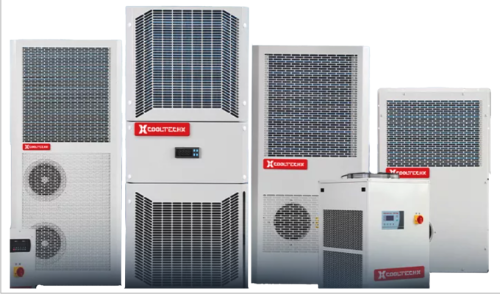
by Amir Sami, Sales Director for Charter Controls
Global warming is undeniable. The use of enclosure air conditioners is often a critical consideration for maintaining the optimal functioning and longevity of electrical components in a more challenging environment. In this short article Amir Sami from Unipower UK Ltd T/A Charter Controls will delve into the reasons behind the need for enclosure air conditioning units, particularly focusing on the scenarios where traditional cooling methods like filter fans fall short.
In previous PBSI issues, article titled
“Keeping your Cool in Control Panel Enclosures” we already highlighted that electrical components within industrial settings generate heat during operation. In many cases, this heat, if not adequately managed, can lead to reduced efficiency, malfunction, or even premature failure of the components. This is particularly relevant in electrical enclosures, housing high-power industrial components or densely packed electrical setups, where the heat generated can be substantial.
Unlike passive cooling methods, enclosure air conditioners actively lower the temperature inside the enclosure. This active cooling is essential in scenarios where internal heat generation is significant, surpassing what passive methods can handle.
Traditional cooling methods, such as filter fans, provide passive cooling by facilitating air circulation. While effective in certain scenarios, they often lack the capacity to counteract the heat generated by high-power components or in densely packed enclosures. Filter fans also depend heavily on the ambient temperature; they are less effective if the external environment is already warm.
Enclosure air conditioners maintain a more consistent internal temperature. This control is crucial for sensitive electronic components that require a stable operating environment for optimal performance and reduced risk of overheating.
In cases where enclosures are small or components are densely packed, the space for effective air circulation is limited making enclosure air conditioners particularly beneficial as they can efficiently manage the thermal environment, even in constrained spaces.
Enclosure air conditioners, especially those with robust designs like those offered by Cooltechx, are built to last. The use of materials like copper in ‘heat exchangers’ and condensers, plus thicker galvanized plates, ensures a longer service life and better heat conduction and dissipation.
Cooltechx air conditioners are designed to withstand various industrial environments, including harsh outdoor conditions. They provide reliable cooling even in the face of environmental challenges like dust, moisture, and corrosive elements.

Essentials in Enclosure Air Conditioning:
A Practical Guide for Selection and what to look for:
When selecting enclosure air conditioners for industrial applications, certain features are essential to ensure they meet your project requirements efficiently and reliably. For indoor applications, it is crucial to choose units with an IP54 rating, which offers sufficient protection against harmful dust and water splashes. This level of protection is vital for maintaining the integrity of the internal components in various industrial environments. In terms of durability and longevity, air conditioners that are capable of operating continuously for 5 to 10 years are desirable, as they indicate robust construction and reliable performance over time. Another important feature is the inclusion of comprehensive alarm functions, which enhance safety and operational awareness by alerting to any critical issues that may arise. The use of eco-friendly refrigerant, particularly R134a, is also a key consideration, aligning with modern environmental standards and ROHS requirements. Additionally, features like Modbus support over RS485 are significant for enabling easy remote monitoring and management, adding a layer of convenience and control to the operation of these units.
For outdoor applications, the requirements for enclosure air conditioners differ slightly. In these settings, an IP56 rating becomes critical, providing enhanced protection against harmful dust and liquid ingress and external elements, ensuring the unit's functionality in tougher outdoor environments. A longer service life, preferably up to 10 years under laboratory conditions, is indicative of an air conditioner's ability to withstand the rigours of outdoor use. Similar to indoor units, having multiple alarm outputs is essential for safety, and the use of eco-friendly R134a refrigerant is crucial for environmental compliance.
Enclosure air conditioners emerge as a pivotal solution in industrial settings for effective thermal management. Their ability to provide active cooling, maintain a controlled environment, and adapt to challenging conditions makes them a superior choice over traditional cooling methods in many scenarios. For specific requirements and solutions please contact Charter Controls team, the strategic partner for Cooltechx in the UK and Ireland who can offer advice and support, ensuring that the cooling solutions align with the technical and operational needs of diverse industrial applications while ensuring added value through tailored commercial industry insights.
Previously Published in PBSI:From Dust to Durability